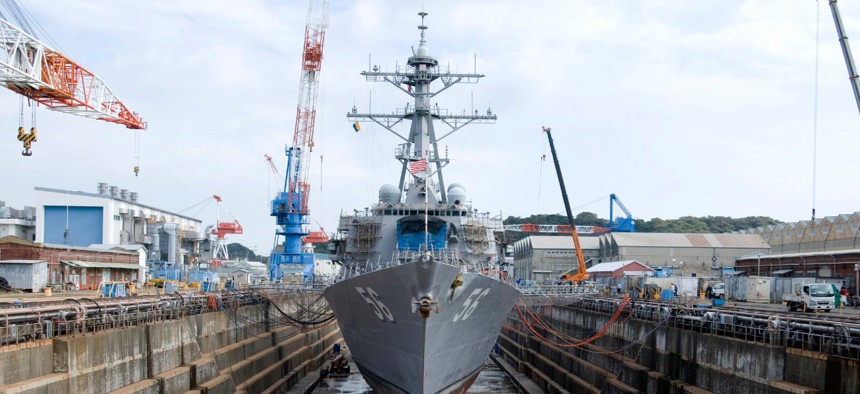
The guided-missile destroyer USS John S. McCain is in dry dock at Fleet Activities Yokosuka during a scheduled dry-dock selective restricted availability. Petty Officer 2nd Class Bryan Reckard / U.S. Navy
America’s shipyards lack the repair capacity the Navy needs in peacetime, let alone during war, a Navy admiral said Tuesday.
Rear Adm. Eric Ver Hage, who leads the Navy Regional Maintenance Center and directs the service’s surface ship maintenance and modernization, became the latest senior officer to paint a grim picture of a shipbuilding sector that has struggled to repair vessels on time and on budget.
“We don’t have enough capacity for peacetime,” Ver Hage said during a Navy League webcast Tuesday. “We have so much to be proud of, but we’re not as effective or efficient [as we should be]. We can’t get ships delivered on time with the predictability that we need today.”
The admiral pointed to the lengthy times to repair the USS Fitzgerald and USS John S. McCain. The Arleigh Burke-class destroyers were heavily damaged during separate collisions with commercial ships in 2017. It took nearly three years to repair the Fitzgerald and more than two years for the Navy to repair the McCain.
It will be a “massive effort” if the Navy chooses to repair the USS Bonhomme Richard, an amphibious assault ship severely damaged in a fire last month, Ver Hage said.
Ver Hage’s comments seemed to echo those of Marine Corps Commandant Gen. David Berger who earlier this year questioned whether the U.S. shipyards could keep pace with China in repairing and replacing war-damaged ships. Berger’s comments came in a draft operating concept obtained by Breaking Defense.
“We don’t have enough capacity,” Ver Hage said. “We’re on the right trajectory, but we have more to do.”
The Navy says it needs 355 ships, but it has not said the types of ships it needs. The Navy did not give Congress a 30-year shipbuilding plan this year.
Two years ago, James “Hondo” Geurts, the head of Navy acquisition, put together a wartime acquisition plan to look at this issue. Geurts — who in his prior role as the head of acquisition for U.S. Special Operations Command focused nearly all of his efforts buying weapons or equipment for troops at war — has used the coronavirus pandemic as a way to shakeup the way the service does business.
“I view acquisition as a tool of war,” Geurts said during a Thursday call with reporters. “I don’t want to be thinking of something for the first time when I have to do it.”
Navy officials have been looking at industrial sectors beyond shipbuilding.
“What the team has been doing is really thinking through where are there friction points, where’s there frugality, where are there plans and authorities that we need to have in mind and in place early and then what would be our execution plan as we went forward,” he said.
The Navy has put together what Rear Adm. Tom Anderson, program executive officer for ships, called a playbook of the authorities it needs from Congress and ways to get vessels out of shipyards faster.
“It goes beyond what we’re currently doing. It really is a more national look at what is the national capacity and how would we energize it,” Anderson said during Tuesday’s Navy League event.
Naval Sea Systems Command has taken stock and inspected drydocks that the Navy could use, if needed, Geurts said.
Geurts said the U.S. has capacity at shipyards ranging in size.
“My goal is to make sure we can take advantage of all of that capacity both in construction and repair as best possible,” he said. “I do think that some of the newer ship classes we’re talking about may open up new opportunities either at the total ship level or at supporting some of the programs [that] have got a lot of work in front of them.”
And there’s plenty of work to go around.
“I’m excited for the opportunity to bring in new players as well as ensure we have the right programs balance to keep our current shipbuilders and their suppliers operating efficiently and effectively.”
While some have argued for more public Navy shipyards, Ver Hage said “public and private investment is needed.”
In a new report released last week, the Government Accountability Office said that “substantial maintenance delays persist at the Navy's shipyards.” Some 75 percent of planned aircraft carrier and submarine maintenance was completed late between 2015 and 2019. The two drivers of the delays: “unplanned work, identified after maintenance planning is finished” and “shipyard workforce performance and capacity.”







